To Be Evita ©
- Part III
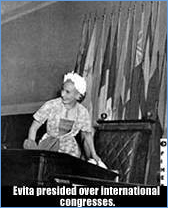 The
María Eva Duarte de Perón Foundation came into being on
June 19, 1948, and obtained non-profit status on July 8. From September
25, 1950, until it was dismantled by the military coup in 1955, it was
known as the Eva Perón Foundation.
The
María Eva Duarte de Perón Foundation came into being on
June 19, 1948, and obtained non-profit status on July 8. From September
25, 1950, until it was dismantled by the military coup in 1955, it was
known as the Eva Perón Foundation.
In her speech of December 5, 1949,
given to the First American Congress of Medicine in the Workplace, Evita
was very clear about why the Foundation was created: to bridge the gaps
in the national safety net (because in any country which is undergoing
a national reorganization there are always gaps to be covered and the
government must be ready with a quick, rapid and efficient response).
She conveyed the idea of transforming the traditional concept of beneficence
and redefining it within the Peronista program of social justice.
From
beneficence ...to social justice
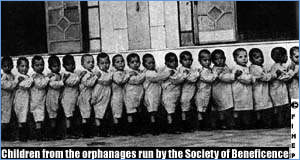
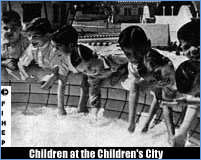
The greatest gaps in the safety
net were found in the assistance provided to the elderly, children and
women.
On August 28, 1948, in the Ministry
of Labor, Evita read the Declaration of the Rights of Senior Citizens.
She then placed it in the hands of the President, asking that it be incorporated
into the legislation and the institutional fabric of the nation. It was
included in the National Constitution of 1949.
The Foundation was not content with
words. It constructed Homes for Senior Citizens; the first residence was
inaugurated on October 17, 1948, in Burzaco. Others were constructed in
the interior of the country. At the same time, Evita obtained the passing
of a law which granted pensions to people over 60 who were without resources.
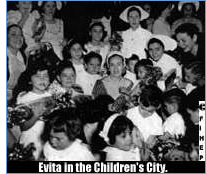 Evita
was especially worried about the education, entertainment and health of
the children and youth of the country. The Foundation set up a plan for
the construction of one thousand schools throughout Argentina, as well
as agricultural schools, workshops, nursery schools and daycare centers.
The Amanda Allen Children's City and the Students' City formed part of
the educational action plan. The Children's City was created to shelter
children from two to seven years of age who were orphans or whose parents'
were unable to care for them. The Students' City was a residence for students
from the interior who came to Buenos Aires to study and had no place to
stay.
Evita
was especially worried about the education, entertainment and health of
the children and youth of the country. The Foundation set up a plan for
the construction of one thousand schools throughout Argentina, as well
as agricultural schools, workshops, nursery schools and daycare centers.
The Amanda Allen Children's City and the Students' City formed part of
the educational action plan. The Children's City was created to shelter
children from two to seven years of age who were orphans or whose parents'
were unable to care for them. The Students' City was a residence for students
from the interior who came to Buenos Aires to study and had no place to
stay.
The Children's Tourism Plan began
in 1950 and enabled children to vacation in the mountains,at the seashore
and in other tourist spots throughout the country. The vacation colonies
were the jewels of this plan.
The Children's Competitions began
in 1948 with soccer and were expanded to include many other sports; they
enabled the Foundation to provide medical checkups to over 300,000 children.
The Children's Hospital and Epidemiology
Center, and the Children's Recuperation Clinic in Terma de Reyes were
among the Foundation's contributions to improving children's health care.
The National Pediatric Hospital was almost finished at the time of the
military coup in 1955. It was never completed.
Evita's work to help children was
inspired in her belief that "the country which forgets its children renounces
its future."
The problem of finding work and
temporary shelter for women was alleviated by constructing and maintaining
three Temporary Homes in Buenos Aires. Other homes were built in the interior.
The General San Martin Home for
Women Employees sought to resolve the problem of single women who needed
permanent lodging.This Home had a dining room where Evita would often
go for supper after her day's work.Here Juan Castiñeira de Dios
organized the Peña Eva Perón. The Peña, or Poetry
Reading,where poets often dedicated their works to Evita, provided her
with much joy and needed relaxation.
|
|
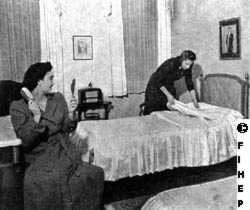 |
Evita
frequently dined at the Hogar de la Empleada (a home for single
working women). The Peña Eva Perón was held in the
dining room. |
|
In
her desire to raise the general standard of living, Eva Perón
provided the working girl with the maximum of comfort, combined
with gracious surroundings. |
To meet health care needs,
the Foundation constructed four polyclinics in Buenos Aires, in
Ezeiza, Avellaneda, Lanus and San Martín, and others in
the interior of the country. The Foundation also donated modern
medical equipment to other hospitals.
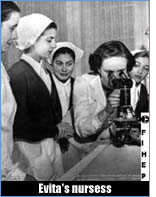 The Eva Perón Hospital
Train, equipped with state-of-the-art medical technology, crisscrossed
the country providing checkups and services to the people in the
most remote areas.
The Eva Perón Hospital
Train, equipped with state-of-the-art medical technology, crisscrossed
the country providing checkups and services to the people in the
most remote areas.
In September, 1951, the
School of Nurses was inaugurated. The School was one of Evita's
most cherished successes; graduates worked all over Argentina
and abroad.
To meet housing needs, the
Foundation constructed workers' homes, such as the President Peron
Neighborhood and Evita City which provided housing for over 25,000
families.
All the Foundation's works
were followed and supervised by Evita, from the drawing board to
their daily operation. She was often accompanied in her tours by
visitors from abroad.
The Foundation also helped
other countries in times of need or catastrophe, as Ecuador, Spain,
Italy, Israel, France, Japan, Peru, and Bolivia (among others) can
testify.
The origin of the funds which the Foundation
used for its works has been an object of controversy in Argentina. The Foundation's
Balance Sheet for 1953 specifies the origin of its funds: cash donations,
mostly from unions but also from individuals and companies; collective bargaining
agreements; taxes; rents; Legislative grants, etc. We must mention that
stories circulated about forced donations where resistance was met with
persecution; the Mu-Mu Candy Factory is cited as an example.
Historian Marysa Navarro, in her
biography Evita, notes: "But if the "spontaneous contributions"
had existed on a large scale and been accepted systematically, those who
were forced could have denounced them after September of 1955. If they
did not wish to denounce them publicly they could have done so before
the commission in charge of investigating the administration of the Foundation
and presumably the commission would have been pleased to receive these
accusations. We must believe that there were not a large number of denunciations
because if there had been, the commission would have listed them and it
does not do so" (Navarro, Marysa: Evita, ed. Planeta, Buenos Aires,
1994, pg. 263).
After Evita's death the Foundation
continued to operate but without its former vigor and achievements. Perón
tried to take her place but two circumstances were different: Perón
was not Evita and the economy was not the same as it had been when Evita
was alive.
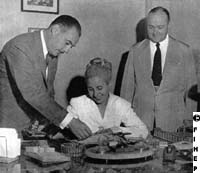
Evita with
her brother Juan Duarte, private secretary to the President and Raúl
Apold from the Subsecretariat of Information. |
As Evita's popularity and
power grew so did criticism from the opposition and (in some cases)
from certain sectors of Peronismo. They attacked from different
angles: activities inappropriate for a First Lady, undistilled resentment,
dangerous influence on Perón, uncontrolled ambition for power.
Under the surface, but not too far under, was the criticism not
of what was being done, or how it was being done, or why it was
being done but that it was being done by a woman. As J.M. Taylor
says, "Evita confronts us with the enigma of power attributed to
a woman in a traditionally and formally patriarchal society, a society
that devalues women as against men." (Taylor, J.M.: Eva Perón,
The Myths of a Woman, University of Chicago Press, Chicago,
1981, pg. 10). |
Evita reached the height of
her power in 1950-1951. These were also the years when she was confronted
with her illness and her last choice: should she be Vice President
of the nation?
On August 2, 1951, the CGT asked Perón to run again for President
(this was possible after the reform of the Constitution in 1949) and expressed
the desire that Evita would be his running mate. Support for the ticket
Perón-Perón grew in the following days.
On August 22, in the historic Cabildo
Abierto de Justicialismo, a mass concentration on Nueve de Julio Avenue,
over a million people voiced their desire and support for Evita's candidacy.
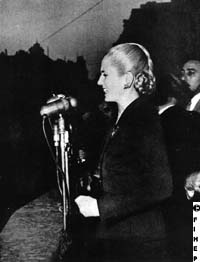 |
Evita spoke
to the multitude but eluded accepting the office of vice president.
The people insisted and a dialogue began whose fervor and intensity
is difficult to put into words. Evita asked for time to think
things over before reaching a decision.
"At least four
days."
"No! Now!"
"I do not renounce
my work, I only renounce the honors ... ."
"Now!"
"I don't want
any worker in my country to be without a response when the resentful,
the mediocre people who never understood me nor never will, who
believe that everything I do is for personal gain ... ."
"Now!"
"One day ...
."
"No!"
"Two hours
... ."
"No!"
Evita left
the microphone. Torches were lit and illuminated a multitude willing
to spend the night there waiting for a reply. Evita took the microphone.
"Friends! As
General Perón said, "I will do as the people ask."
The dialogue
was over. The people believed she had accepted. |
| Evita
dialogues with over a million people who want to vote for the ticket
Perón-Perón. |
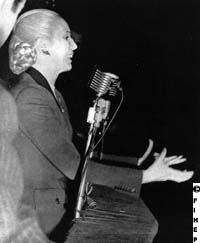 |
On August 31, in a nationwide broadcast,
Evita announced her "irrevocable decision to renounce the honor which
the workers and the people" had wished to bestow on her.
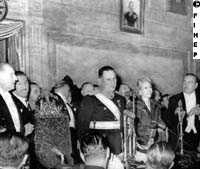
June, 1952.
Perón's second inauguration and Evita's last public appearance.
|
The background behind the
story of Evita's renunciation has yet to be written. There are many
threads to be woven together ... the Armed Forces, her illness,
the CGT, the people, Evita herself.
The Perón-Quijano ticket
won the November elections. Evita voted from her sickbed in the
Polyclinic in Avellaneda for the first and last time.
She accompanied Perón
during his second inauguration.
It was her last public appearance. |
Her work had become a part of the
thousands of men, women, and children who mourned her. In only thirty-three
years Evita had found the reason for her life and had left to others,
as she herself once said when she inaugurated a polyclinic, the easiest
task: that of changing the names of the works she had built.
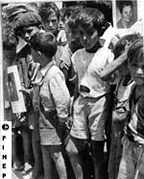
|
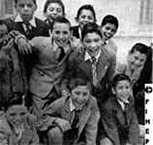
Evita's love
for her people changed their lives. |
To
Be Evita ©
Biography
Evita Peron Historical Research Foundation
Translation by Dolane Larson
Hecho el depósito que marca la ley 11.723
May not be reproduced in total or partial form
without authorization of the FIHEP
April, 1997
